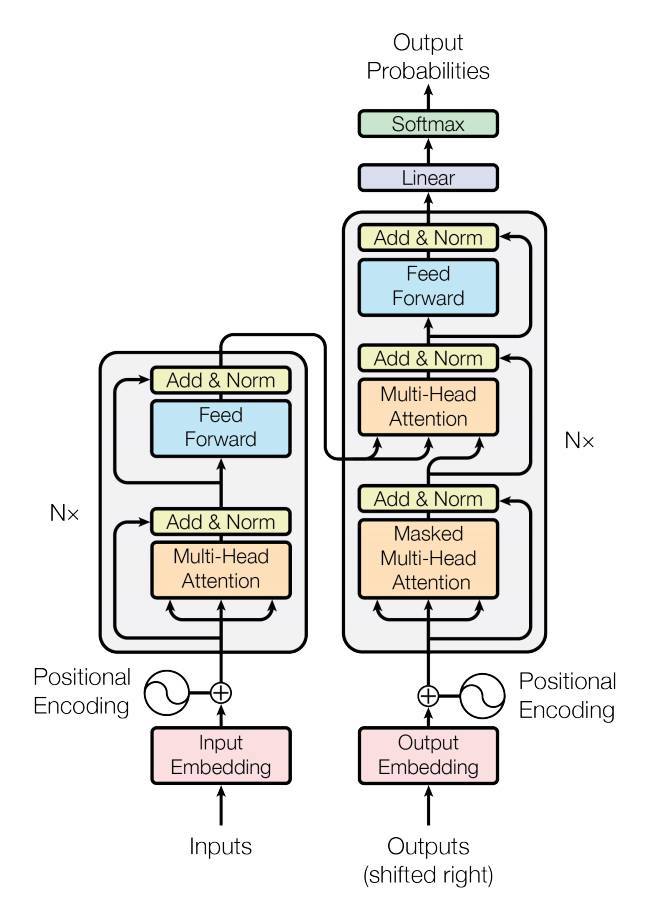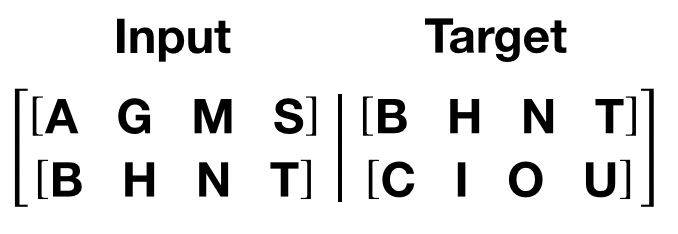注意
here下载完整的示例代码
使用 nn.Transformer 和 TorchText 进行序列到序列建模¶
这是一个有关如何使用 nn.Transformer 模块训练序列到序列模型的教程。
PyTorch 1.2 版本含有一个基于论文 Attention is All You Need 的标准 transformer 模块。 Transformer 模型已被证明在许多序列到序列问题上具有更好的效果,同时具有更高的可并行性。 nn.Transformer模块完全依赖于注意机制(最近实现的另外一个模块nn.MultiheadAttention),以在输入和输出之间绘制全局依赖关系。 nn.Transformer模块现在高度模块化,因此单个组件(如本教程中的nn.TransformerEncoder)可以轻松调整/组合。

定义模型|
在本教程中,我们将训练nn.TransformerEncoder模型。 语言建模任务是根据一个单词序列对给定的单词(或单词序列)分配一个概率。 首先将一系列 token 传递给嵌入层,然后是考虑单词顺序的位置编码层(有关详细信息,请参阅下一段)。 nn.TransformerEncoder由多层 nn.TransformerEncoderLayer 组成。 与输入序列一起还需要一个方形的注意力掩码,因为nn.TransformerEncoder中的自注意层以只允许关注序列中的较早位置。 对于语言建模任务,应屏蔽未来位置上的任何标记。 为了获得实际的单词,将nn.TransformerEncoder模型的输出发送到最终的 Linear 层,其后是 log-Softmax 函数。
import math
import torch
import torch.nn as nn
import torch.nn.functional as F
class TransformerModel(nn.Module):
def __init__(self, ntoken, ninp, nhead, nhid, nlayers, dropout=0.5):
super(TransformerModel, self).__init__()
from torch.nn import TransformerEncoder, TransformerEncoderLayer
self.model_type = 'Transformer'
self.src_mask = None
self.pos_encoder = PositionalEncoding(ninp, dropout)
encoder_layers = TransformerEncoderLayer(ninp, nhead, nhid, dropout)
self.transformer_encoder = TransformerEncoder(encoder_layers, nlayers)
self.encoder = nn.Embedding(ntoken, ninp)
self.ninp = ninp
self.decoder = nn.Linear(ninp, ntoken)
self.init_weights()
def _generate_square_subsequent_mask(self, sz):
mask = (torch.triu(torch.ones(sz, sz)) == 1).transpose(0, 1)
mask = mask.float().masked_fill(mask == 0, float('-inf')).masked_fill(mask == 1, float(0.0))
return mask
def init_weights(self):
initrange = 0.1
self.encoder.weight.data.uniform_(-initrange, initrange)
self.decoder.bias.data.zero_()
self.decoder.weight.data.uniform_(-initrange, initrange)
def forward(self, src):
if self.src_mask is None or self.src_mask.size(0) != len(src):
device = src.device
mask = self._generate_square_subsequent_mask(len(src)).to(device)
self.src_mask = mask
src = self.encoder(src) * math.sqrt(self.ninp)
src = self.pos_encoder(src)
output = self.transformer_encoder(src, self.src_mask)
output = self.decoder(output)
return output
PositionalEncoding模块注入一些 Token 在序列中的相对或绝对位置的信息。 位置编码与嵌入具有相同的维度,因此可以求和两者。 在这里,我们使用不同频率的sine和cosine函数。
class PositionalEncoding(nn.Module):
def __init__(self, d_model, dropout=0.1, max_len=5000):
super(PositionalEncoding, self).__init__()
self.dropout = nn.Dropout(p=dropout)
pe = torch.zeros(max_len, d_model)
position = torch.arange(0, max_len, dtype=torch.float).unsqueeze(1)
div_term = torch.exp(torch.arange(0, d_model, 2).float() * (-math.log(10000.0) / d_model))
pe[:, 0::2] = torch.sin(position * div_term)
pe[:, 1::2] = torch.cos(position * div_term)
pe = pe.unsqueeze(0).transpose(0, 1)
self.register_buffer('pe', pe)
def forward(self, x):
x = x + self.pe[:x.size(0), :]
return self.dropout(x)
加载和批处理数据|
训练过程使用来自torchtext的Wikitext-2数据集。 vocab 对象基于训练数据集构建,用于将 Token 数值化为张量。 数据从顺序开始,batchify()函数将数据集排列为列,数据分成大小为batch_size的批次,剩余的所有 Token 去掉。
例如,以字母表为序列(总长度为 26)以及批处理大小为 4,我们将字母表划分为长度为 6 的 4 个序列:
这些列被模型视为独立列,这意味着无法学习G和F的依赖性,但允许更高效的批处理。
import torchtext
from torchtext.data.utils import get_tokenizer
文本 = torchtext.data.Field(tokenize=get_tokenizer("basic_english"),
init_token='<sos>',
eos_token='<eos>',
lower=True)
train_txt, val_txt, test_txt = torchtext.datasets.WikiText2.splits(TEXT)
TEXT.build_vocab(train_txt)
device = torch.device("cuda" if torch.cuda.is_available() else "cpu")
def batchify(data, bsz):
data = TEXT.numericalize([data.examples[0].text])
# Divide the dataset into bsz parts.
nbatch = data.size(0) // bsz
# Trim off any extra elements that wouldn't cleanly fit (remainders).
data = data.narrow(0, 0, nbatch * bsz)
# Evenly divide the data across the bsz batches.
data = data.view(bsz, -1).t().contiguous()
return data.to(device)
batch_size = 20
eval_batch_size = 10
train_data = batchify(train_txt, batch_size)
val_data = batchify(val_txt, eval_batch_size)
test_data = batchify(test_txt, eval_batch_size)
输出:
downloading wikitext-2-v1.zip
extracting
用于生成输入和目标序列的函数|
get_batch()函数为 transformer 模型生成输入和目标序列。 它将源数据细分成长度为bptt的块。 对于语言建模任务,模型需要以下单词作为Target。 例如,bptt值为 2,我们将获得以下两个变量,用于i = 0:

需要注意的是,块沿维度 0,与 Transformer 模型中的S维度一致。 批处理维度N沿维度 1。
bptt = 35
def get_batch(source, i):
seq_len = min(bptt, len(source) - 1 - i)
data = source[i:i+seq_len]
target = source[i+1:i+1+seq_len].view(-1)
return data, target
初始化一个实例¶
模型使用下面的超参数进行设置。 词汇量大小等于 vocab 对象的长度。
ntokens = len(TEXT.vocab.stoi) # the size of vocabulary
emsize = 200 # embedding dimension
nhid = 200 # the dimension of the feedforward network model in nn.TransformerEncoder
nlayers = 2 # the number of nn.TransformerEncoderLayer in nn.TransformerEncoder
nhead = 2 # the number of heads in the multiheadattention models
dropout = 0.2 # the dropout value
model = TransformerModel(ntokens, emsize, nhead, nhid, nlayers, dropout).to(device)
运行模型|
CrossEntropyLoss 用于跟踪损失,SGD 实现随机梯度下降方法作为优化器。 初始学习速率设置为 5.0。 使用 StepLR 来调整每个 epoch 的学习速率。 在训练期间,我们使用 nn.utils.clip_grad_norm_ 函数将所有梯度一起缩放以防止梯度爆炸。
criterion = nn.CrossEntropyLoss()
lr = 5.0 # learning rate
optimizer = torch.optim.SGD(model.parameters(), lr=lr)
scheduler = torch.optim.lr_scheduler.StepLR(optimizer, 1.0, gamma=0.95)
import time
def train():
model.train() # Turn on the train mode
total_loss = 0.
start_time = time.time()
ntokens = len(TEXT.vocab.stoi)
for batch, i in enumerate(range(0, train_data.size(0) - 1, bptt)):
data, targets = get_batch(train_data, i)
optimizer.zero_grad()
output = model(data)
loss = criterion(output.view(-1, ntokens), targets)
loss.backward()
torch.nn.utils.clip_grad_norm_(model.parameters(), 0.5)
optimizer.step()
total_loss += loss.item()
log_interval = 200
if batch % log_interval == 0 and batch > 0:
cur_loss = total_loss / log_interval
elapsed = time.time() - start_time
print('| epoch {:3d} | {:5d}/{:5d} batches | '
'lr {:02.2f} | ms/batch {:5.2f} | '
'loss {:5.2f} | ppl {:8.2f}'.format(
epoch, batch, len(train_data) // bptt, scheduler.get_lr()[0],
elapsed * 1000 / log_interval,
cur_loss, math.exp(cur_loss)))
total_loss = 0
start_time = time.time()
def evaluate(eval_model, data_source):
eval_model.eval() # Turn on the evaluation mode
total_loss = 0.
ntokens = len(TEXT.vocab.stoi)
with torch.no_grad():
for i in range(0, data_source.size(0) - 1, bptt):
data, targets = get_batch(data_source, i)
output = eval_model(data)
output_flat = output.view(-1, ntokens)
total_loss += len(data) * criterion(output_flat, targets).item()
return total_loss / (len(data_source) - 1)
循环每个 epoch。 如果验证集损失是目前我们所看到的最好的,则保存模型。 调整每个 epoch 之后的学习速率。
best_val_loss = float("inf")
epochs = 3 # The number of epochs
best_model = None
for epoch in range(1, epochs + 1):
epoch_start_time = time.time()
train()
val_loss = evaluate(model, val_data)
print('-' * 89)
print('| end of epoch {:3d} | time: {:5.2f}s | valid loss {:5.2f} | '
'valid ppl {:8.2f}'.format(epoch, (time.time() - epoch_start_time),
val_loss, math.exp(val_loss)))
print('-' * 89)
if val_loss < best_val_loss:
best_val_loss = val_loss
best_model = model
scheduler.step()
输出:
| epoch 1 | 200/ 2981 batches | lr 5.00 | ms/batch 124.93 | loss 7.99 | ppl 2949.14
| epoch 1 | 400/ 2981 batches | lr 5.00 | ms/batch 122.26 | loss 6.78 | ppl 878.40
| epoch 1 | 600/ 2981 batches | lr 5.00 | ms/batch 121.36 | loss 6.37 | ppl 582.49
| epoch 1 | 800/ 2981 batches | lr 5.00 | ms/batch 123.27 | loss 6.23 | ppl 505.39
| epoch 1 | 1000/ 2981 batches | lr 5.00 | ms/batch 122.21 | loss 6.11 | ppl 450.76
| epoch 1 | 1200/ 2981 batches | lr 5.00 | ms/batch 122.75 | loss 6.09 | ppl 441.42
| epoch 1 | 1400/ 2981 batches | lr 5.00 | ms/batch 122.13 | loss 6.05 | ppl 422.40
| epoch 1 | 1600/ 2981 batches | lr 5.00 | ms/batch 124.62 | loss 6.05 | ppl 425.40
| epoch 1 | 1800/ 2981 batches | lr 5.00 | ms/batch 126.22 | loss 5.96 | ppl 386.09
| epoch 1 | 2000/ 2981 batches | lr 5.00 | ms/batch 127.20 | loss 5.96 | ppl 388.86
| epoch 1 | 2200/ 2981 batches | lr 5.00 | ms/batch 127.03 | loss 5.85 | ppl 346.01
| epoch 1 | 2400/ 2981 batches | lr 5.00 | ms/batch 127.34 | loss 5.90 | ppl 364.58
| epoch 1 | 2600/ 2981 batches | lr 5.00 | ms/batch 128.40 | loss 5.90 | ppl 365.37
| epoch 1 | 2800/ 2981 batches | lr 5.00 | ms/batch 129.84 | loss 5.80 | ppl 331.25
-----------------------------------------------------------------------------------------
| end of epoch 1 | time: 387.28s | valid loss 5.78 | valid ppl 323.73
-----------------------------------------------------------------------------------------
| epoch 2 | 200/ 2981 batches | lr 4.75 | ms/batch 128.02 | loss 5.79 | ppl 327.90
| epoch 2 | 400/ 2981 batches | lr 4.75 | ms/batch 128.10 | loss 5.77 | ppl 320.35
| epoch 2 | 600/ 2981 batches | lr 4.75 | ms/batch 130.64 | loss 5.60 | ppl 271.34
| epoch 2 | 800/ 2981 batches | lr 4.75 | ms/batch 129.98 | loss 5.64 | ppl 280.59
| epoch 2 | 1000/ 2981 batches | lr 4.75 | ms/batch 131.43 | loss 5.59 | ppl 268.89
| epoch 2 | 1200/ 2981 batches | lr 4.75 | ms/batch 132.91 | loss 5.62 | ppl 276.06
| epoch 2 | 1400/ 2981 batches | lr 4.75 | ms/batch 129.21 | loss 5.63 | ppl 277.27
| epoch 2 | 1600/ 2981 batches | lr 4.75 | ms/batch 128.28 | loss 5.66 | ppl 287.70
| epoch 2 | 1800/ 2981 batches | lr 4.75 | ms/batch 130.00 | loss 5.58 | ppl 266.11
| epoch 2 | 2000/ 2981 batches | lr 4.75 | ms/batch 130.06 | loss 5.62 | ppl 275.50
| epoch 2 | 2200/ 2981 batches | lr 4.75 | ms/batch 131.11 | loss 5.51 | ppl 246.58
| epoch 2 | 2400/ 2981 batches | lr 4.75 | ms/batch 129.66 | loss 5.60 | ppl 269.79
| epoch 2 | 2600/ 2981 batches | lr 4.75 | ms/batch 130.27 | loss 5.59 | ppl 267.55
| epoch 2 | 2800/ 2981 batches | lr 4.75 | ms/batch 128.42 | loss 5.51 | ppl 248.02
-----------------------------------------------------------------------------------------
| end of epoch 2 | time: 400.31s | valid loss 5.57 | valid ppl 263.33
-----------------------------------------------------------------------------------------
| epoch 3 | 200/ 2981 batches | lr 4.51 | ms/batch 130.83 | loss 5.55 | ppl 258.11
| epoch 3 | 400/ 2981 batches | lr 4.51 | ms/batch 129.35 | loss 5.54 | ppl 255.92
| epoch 3 | 600/ 2981 batches | lr 4.51 | ms/batch 129.45 | loss 5.36 | ppl 213.36
| epoch 3 | 800/ 2981 batches | lr 4.51 | ms/batch 128.86 | loss 5.42 | ppl 225.10
| epoch 3 | 1000/ 2981 batches | lr 4.51 | ms/batch 128.21 | loss 5.38 | ppl 216.61
| epoch 3 | 1200/ 2981 batches | lr 4.51 | ms/batch 129.17 | loss 5.42 | ppl 225.47
| epoch 3 | 1400/ 2981 batches | lr 4.51 | ms/batch 128.17 | loss 5.45 | ppl 231.99
| epoch 3 | 1600/ 2981 batches | lr 4.51 | ms/batch 128.30 | loss 5.48 | ppl 240.22
| epoch 3 | 1800/ 2981 batches | lr 4.51 | ms/batch 127.26 | loss 5.41 | ppl 223.74
| epoch 3 | 2000/ 2981 batches | lr 4.51 | ms/batch 128.67 | loss 5.44 | ppl 230.29
| epoch 3 | 2200/ 2981 batches | lr 4.51 | ms/batch 128.46 | loss 5.33 | ppl 206.34
| epoch 3 | 2400/ 2981 batches | lr 4.51 | ms/batch 127.41 | loss 5.41 | ppl 223.09
| epoch 3 | 2600/ 2981 batches | lr 4.51 | ms/batch 134.35 | loss 5.42 | ppl 225.49
| epoch 3 | 2800/ 2981 batches | lr 4.51 | ms/batch 128.57 | loss 5.35 | ppl 210.62
-----------------------------------------------------------------------------------------
| end of epoch 3 | time: 397.84s | valid loss 5.52 | valid ppl 250.16
-----------------------------------------------------------------------------------------
使用测试数据集评估模型|
应用最佳模型以使用测试数据集检查结果。
test_loss = evaluate(best_model, test_data)
print('=' * 89)
print('| End of training | test loss {:5.2f} | test ppl {:8.2f}'.format(
test_loss, math.exp(test_loss)))
print('=' * 89)
输出:
=========================================================================================
| End of training | test loss 5.43 | test ppl 228.85
=========================================================================================
脚本总运行时间: (33分24.345秒)


